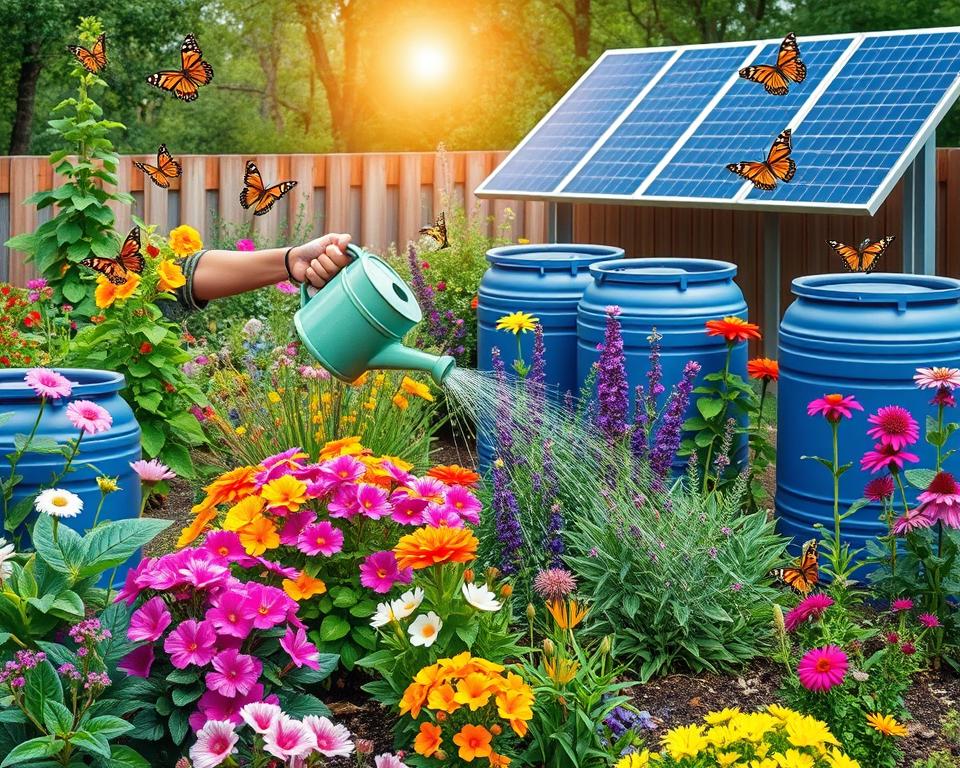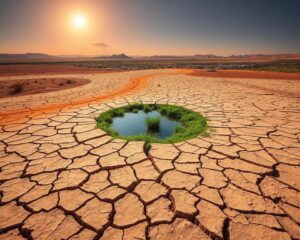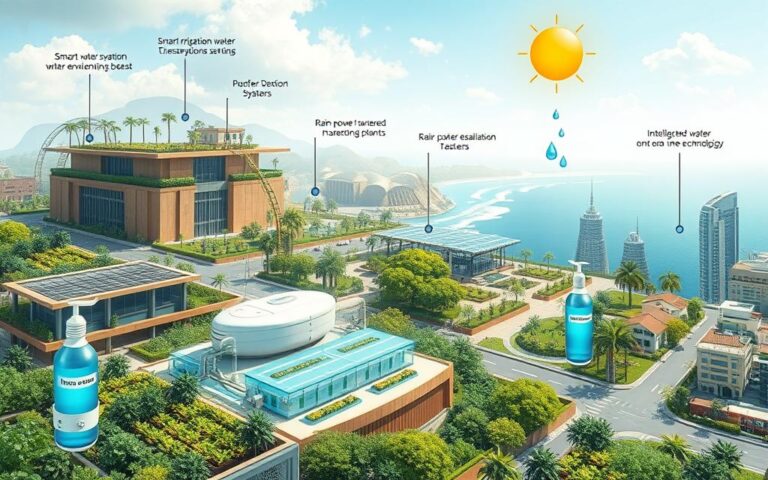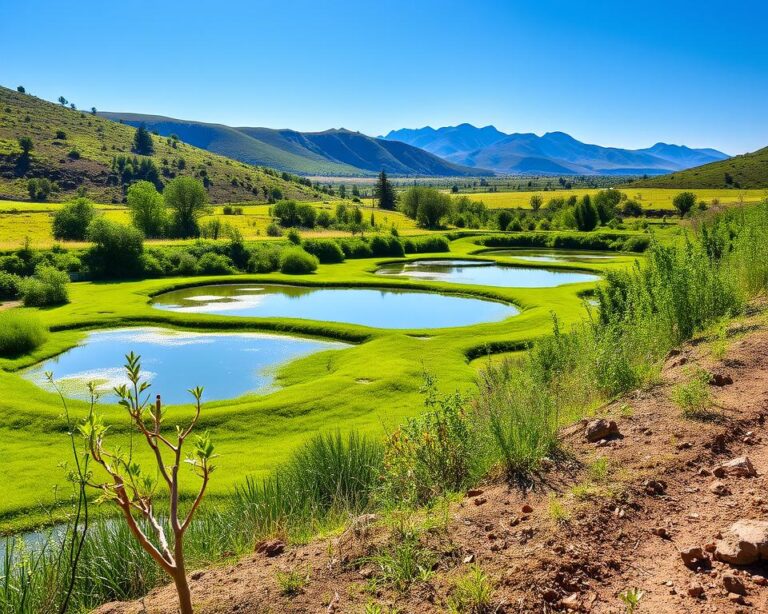Did you know over 2 billion people worldwide lack access to safe drinking water? This shocking fact shows the water scarcity crisis affecting every continent. Poorer communities suffer the most. As the global population grows, meeting water demand becomes harder.
Climate change makes water sources even more unpredictable. This worsens the challenge of using water sustainably.
The water scarcity crisis has big effects. Women and girls face big challenges getting clean water. This affects their health, safety, and job chances. Many countries lack the data needed for good water management.
There’s a need for integrated water resource management (IWRM). It must match water use with community and environmental needs.
Innovative solutions and community awareness are key to solving the water crisis. Let’s explore the causes, effects, and solutions. We’ll see how our water resources are deeply connected.
What is Water Scarcity?
Water scarcity is a big problem affecting millions worldwide. It happens when we need more clean water than we have. Looking at global water stats helps us understand how serious it is.
Definition and Overview
Water scarcity means we don’t have enough clean water for daily needs. It’s split into two types: *physical scarcity* and *economic scarcity*. Physical scarcity happens in areas with drought or too much groundwater use. Economic scarcity is due to bad infrastructure, lack of funds, or poor management.
This issue affects over one billion people. They face water shortages all year.
Key Statistics on Water Availability
Water shortage stats show how serious this crisis is:
- Nearly three billion people don’t have reliable water for at least a month.
- Only 3% of the world’s water is fresh, and only one-third of that is easily accessible.
- Despite having half of Africa’s water, over thirty-three million in the Democratic Republic of Congo lack clean water.
- The global economy loses about $260 billion each year because of bad water and sanitation.
- In the U.S., leaky pipes waste six billion gallons of drinking water every day.
Half a billion people live in severe water scarcity all year. Around four billion face shortages for at least a month. Places with economic water scarcity are growing, especially in Sub-Saharan Africa. We need to work together to solve this problem.
Causes of Water Scarcity
Understanding the causes of water scarcity is key to solving this crisis. Many factors lead to this issue, affecting people worldwide. Let’s look at how climate change, population growth, and farming inefficiency harm our water supply.
Climate Change and Its Role
Climate change is changing where and how much water we get. Rising temperatures change rain patterns and increase evaporation. This has led to less water from glaciers, like the 13.9% drop in China’s Yangtze River since the 1990s.
These changes are serious. Soon, nearly two-thirds of the world’s people will face water shortages. This is because of climate change.
Population Growth and Urbanization
The fast growth of population and cities is straining water resources. Cities need more water for homes and sanitation. Today, 2.3 billion people live in water-stressed areas.
If things keep going, 700 million people could lose their homes due to water scarcity by 2030. This is a big problem.
Inefficient Water Use in Agriculture
About 70% of freshwater is used for farming. Sadly, agricultural inefficiency makes things worse. We need to grow more food by 2050, but water is limited.
We must find ways to use water better in farming. This is crucial for food and fighting water scarcity.
| Factor | Impact on Water Scarcity |
|---|---|
| Climate Change | Altered precipitation and increased evaporation, resulting in reduced available water sources. |
| Population Growth | Increased demand for water resources leading to unsustainable consumption. |
| Agricultural Inefficiency | Excessive water withdrawals for food production, threatening long-term viability of water supply. |
The Effects of Water Scarcity
Water scarcity brings many challenges that affect life in many ways. It impacts the economy, health, and the environment. It’s important to understand these effects to tackle the water crisis.
Economic Impacts on Communities
Water scarcity has huge economic costs. Communities worldwide face big financial losses because of lack of water. The agriculture sector, which uses 70% of freshwater, is hit hard.
It takes a lot of water to grow food, leading to higher prices. This affects nutrition and stability in communities.
Health Risks Associated with Water Shortage
Water scarcity also has serious health effects. It leads to diseases, causing over 1 million deaths each year. Children and the elderly are especially at risk.
Droughts make water pollution worse, posing more health threats. Mental health problems also rise, causing anxiety and stress.
Environmental Consequences and Biodiversity Loss
Water scarcity has severe environmental impacts, causing biodiversity loss. Ecosystems are harmed as water storage decreases. Glaciers and snow cover are also expected to shrink.
These changes harm biodiversity and disrupt food webs. They have lasting effects on our planet.
| Impact | Description |
|---|---|
| Economic Loss | Communities face financial hardships due to increased food prices and reduced agricultural output. |
| Health Risks | Over 1 million deaths annually from water-related diseases; increased mental health issues. |
| Biodiversity Loss | Habitat destruction leads to declining wildlife populations and increased extinction rates. |
Regions Most Affected by Water Scarcity
Water scarcity is a big problem worldwide. It affects many areas, causing serious issues. North America, the Middle East, and Sub-Saharan Africa are especially hit hard.
North America: Localized Challenges
In North America, water scarcity is a local problem. Old pipes and polluted water are big issues. For example, the Flint water crisis shows how pollution can harm water access.
Even though water stress is not extreme everywhere, some places like California face big challenges. This is especially true during droughts.
The Middle East: A Water-Stressed Region
The Middle East faces severe water stress. About 83% of its people deal with severe water shortages. Countries like Yemen and the United Arab Emirates struggle to get enough water.
By 2050, 100% of the population will face extremely high water stress. This will make social and economic problems worse.
Sub-Saharan Africa: A Critical Situation
Sub-Saharan Africa has some of the worst water problems. The population’s water demand will increase by 163% by 2050. Clean water is essential for health and the economy, but many lack it.
This situation leads to health problems and holds back economic growth. It traps poor communities in a cycle of poverty.
How Water Scarcity Affects Daily Life
Water scarcity brings big challenges to our daily lives. It affects how we use water at home and impacts food prices. It’s important to know these effects to find ways to solve this crisis.
Impact on Household Water Usage
Water scarcity leads to big problems with household water usage. Families without clean water might use dirty water, risking their health. This can make them spend more on bottled water.
Trying to save water can also cause stress. Households struggle to manage their limited water resources.
Effect on Food Supply and Prices
Water affects how much food we can grow, leading to higher food prices. Farms use a lot of water, and without it, crops fail. This makes food more expensive, hurting those who can’t afford it.
Many families have to choose between food and health because of these prices. This is a big problem for those already struggling to find enough to eat.
Statistics show that 1.2 billion people live in areas where water is scarce. This makes life harder for many, affecting their daily lives and communities.
| Issue | Statistics |
|---|---|
| Access to Safe Water | 2.2 billion people lack access globally |
| Health Impacts | 1 million people die annually from water-related diseases |
| Children’s Mortality | 395,000 children under 5 could be saved with better water access |
| Food Insecurity | 1 in 4 children suffers from stunting linked to water scarcity |
Dealing with water scarcity needs everyone’s help. We must work together to find ways to use water better. This way, we can make sure everyone has enough water.
Innovative Solutions to Combat Water Scarcity
Dealing with water scarcity needs a mix of new technologies and green practices. We must find ways to meet the increasing need for clean water. Here are some effective strategies to address this critical issue.
Water Recycling and Reuse Technologies
Water recycling is key to using less fresh water from nature. It treats wastewater so it can be reused. For example, Membrane Bioreactors (MBR) can make wastewater safe for drinking or farming.
This approach not only saves water but also helps grow crops. It’s a win-win for both people and the environment.
Rainwater Harvesting Practices
Rainwater harvesting is a smart way to add to our water supply, especially in rainy areas. It collects rainwater for use when it’s needed most. This method is great for cities where water is scarce.
It helps reduce our need for water from far away. This makes it a valuable tool in the fight against water scarcity.
Desalination as a Viable Option
Desalination is a hopeful solution for areas with little water. Countries like Saudi Arabia and Israel use it to make seawater drinkable. It’s not cheap or easy, but it’s getting better.
New technologies are making it more efficient. This means places with little water can now have a steady supply.

Role of Government in Water Management
Effective government water management is key for sustainable water use and tackling water scarcity. Governments can set up rules for responsible water use and conservation. It’s important for different government agencies to work together to improve monitoring, planning, and community involvement.
Policies for Sustainable Water Use
Governments must create and enforce policies for sustainable water use. These policies focus on managing water resources for the long term. They include:
- Regulations on water extraction, balancing human needs and environmental health.
- Incentives for businesses and homes to use water-saving technologies.
- Support for research and innovation in alternative water sourcing, like Atmospheric Water Generation (AWG) technology.
These steps help ensure sustainability and resilience during natural water shortages. When done right, they help manage water use globally.
Funding and Infrastructure Development
Funding for water infrastructure is crucial for government water management. In the U.S., about 90 percent of people rely on government water services. This shows how important it is to invest in infrastructure for clean drinking water.
The U.S. Environmental Protection Agency gives out about $4 billion in grants yearly for clean water projects. This money is key for fixing old pipes, expanding treatment plants, and improving water services. By focusing on water infrastructure funding, governments can protect water resources and support public health.
The Importance of Community Involvement
Getting the community involved in water management is key to solving water scarcity. It makes people feel responsible and helps water conservation efforts succeed. Teaching people about sustainable water use empowers them to make a difference.
This teamwork brings big benefits for everyone and the planet.
Grassroots Education Programs
Grassroots education helps people understand how to save water. Groups like the London Water Exchange teach practical skills. This leads to a 15% increase in knowing how water affects the environment.
People learn to use water wisely, helping their community too.
Community-Based Water Conservation Efforts
When communities work together, water saving goes up by 25%. These efforts also cut water inequality by 30% among different groups. It builds trust and openness among all involved.
Community-led projects show great success. Neighborhoods get 40% more into saving water. Local knowledge makes water projects 20% better.
This teamwork ensures water is used wisely for future generations.
How You Can Help Address Water Scarcity
Water scarcity is a big problem worldwide, with two billion people without clean water. You can help a lot by making small changes. Saving water is key to a better future. Start by trying new ways to save water and help your community.
Tips for Reducing Your Water Footprint
- Fix leaks in your home to prevent waste. A dripping faucet may seem trivial, yet it can waste gallons over time.
- Install water-efficient appliances like low-flow showerheads and dual-flush toilets.
- Practice mindful watering in your garden, opting for drought-resistant plants that require less irrigation.
- Limit outdoor water use during peak evaporation times, typically late morning and early afternoon.
- Be conscious of your shower time and aim to keep it under five minutes.
Supporting Local Water Conservation Initiatives
Helping your community can make a big difference. You can support local water efforts by:
- Joining neighborhood clean-up events that target local water sources.
- Promoting awareness about safe water practices in schools and community centers.
- Contributing to local organizations focused on restoring ecosystems and safeguarding water supplies.
- Advocating for policies that support sustainable water management and protect local resources.

Your actions help reduce water waste in your area. By working together, we can make a big impact. Every step you take helps improve water conservation.
Future of Water Scarcity Issues
As the world’s population grows, water scarcity becomes a bigger problem. We’re facing a huge increase in water needs due to cities growing and climate change. Already, many city dwellers live in areas where water is scarce, and this number is expected to rise.
Predictions for Global Water Needs
By 2050, the number of people in cities facing water scarcity could reach 1.693 billion to 2.373 billion. This is a huge jump from 933 million in 2016. India, for example, will see a massive increase in water-scarce cities, from 222 million in 2016 to 550 million by mid-century.
Almost half of the world’s large cities will struggle with water scarcity. This number could grow from 193 to 284 cities. It’s a worrying trend for cities around the globe.
The Role of Technology in Solutions
Technology offers hope for solving water scarcity issues. New irrigation methods and smart water systems can use water more efficiently. Desalination technologies can also provide water for dry areas, helping communities adapt.
To tackle water scarcity, we must use these technologies. This way, both cities and rural areas can have reliable access to water.
Conclusion: Your Role in the Water Crisis
Understanding water scarcity is more than just learning; it’s a call to act. In the United States, 2.2 million people lack running water. This crisis costs communities about $8.58 billion each year. It also hurts marginalized groups, like Latinos, Black, and Indigenous communities, with poor water systems.
Water insecurity can cause serious health problems. These range from short-term issues to long-term diseases like diabetes and cancer. Knowing these problems is the first step to solving them.
Your role in this crisis is huge. By using less water and spreading awareness, you help solve the problem. Climate change and economic issues make the crisis worse. Every small action, like fixing leaks or supporting local water projects, helps.
It’s important to see how we all play a part in this crisis. Think about how you can help in your community. Encourage others to join you. Together, we can create a better water future.




